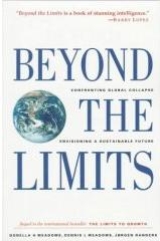
Beyond the Limits
Encyclopedia
Beyond the Limits is a 1992 book continuing the modeling of the consequences of a rapidly growing global population that was started in Limits to Growth
. Donella Meadows
, Dennis Meadows
, and Jorgen Randers are the authors and all were involved in the original Club of Rome
study as well. Beyond the Limits (Chelsea Green Publishing Company) and Earthscan addressed many of the criticisms of the Limits of Growth book, but still has caused controversy and mixed reactions.
indicates having been influenced by reading Beyond the Limits.
Limits to Growth
The Limits to Growth is a 1972 book modeling the consequences of a rapidly growing world population and finite resource supplies, commissioned by the Club of Rome. Its authors were Donella H. Meadows, Dennis L. Meadows, Jørgen Randers, and William W. Behrens III. The book used the World3 model to...
. Donella Meadows
Donella Meadows
Donella H. "Dana" Meadows was a pioneering American environmental scientist, teacher and writer. She is best known as lead author of the influential book The Limits to Growth, which made headlines around the world.- Life :Born in Elgin, Illinois, Meadows was educated in science, receiving a B.A...
, Dennis Meadows
Dennis Meadows
Dennis L. Meadows is an American scientist and Emeritus Professor of Systems Management, and former director of the Institute for Policy and Social Science Research at the University of New Hampshire...
, and Jorgen Randers are the authors and all were involved in the original Club of Rome
Club of Rome
The Club of Rome is a global think tank that deals with a variety of international political issues. Founded in 1968 at Accademia dei Lincei in Rome, Italy, the CoR describes itself as "a group of world citizens, sharing a common concern for the future of humanity." It consists of current and...
study as well. Beyond the Limits (Chelsea Green Publishing Company) and Earthscan addressed many of the criticisms of the Limits of Growth book, but still has caused controversy and mixed reactions.
Reviews
- "Society has gone into overshoot, … a state of being beyond limits without knowing it. These limits are more like speed limits than barriers at the end of the road: the rate at which renewable resources can renew themselves, the rate at which we can change from nonrenewable resources to renewable ones, and the rate at which nature can recycle our pollution. … [W]e are overshooting such crucial resources as food and water while overwhelming nature with pollutants like those causing global warming."
- "Beyond the Limits recognizes that the future doesn't lie in tinkering with resource use or simply squelching population growth in developing countries. A sustainable future will require profound social and psychological readjustments in the developed and developing world."
- "Current crop yields can only sustain the world's population at subsistence levels, … while nonrenewable energy resources and fresh water supplies are dwindling, and greenhouse gases and other pollutants increase. But while the prognosis is disaster within decades if nothing is done, there are encouraging signs. Technology offers greater efficiency in energy consumption and pollution control, international response to the ozone crisis has been relatively swift, and recycling efforts are gaining headway. [However] … the conditions underlying limit overshoots--population growth and resource depletion in a finite world, for example--remain unaddressed in the corridors of power."
Influence
Billionaire investor Richard RainwaterRichard Rainwater
-Early life:The son of a wholesale grocer, he grew up in Fort Worth, Texas. He graduated from the University of Texas with a degree in mathematics, where he was a member of the Tau chapter of the Kappa Sigma fraternity. He was recognized by the national organization in 1996 as Kappa Sigma Man of...
indicates having been influenced by reading Beyond the Limits.
See also
- Donella Meadows' twelve leverage points to intervene in a system
- World3World3The World3 model was a computer simulation of interactions between population, industrial growth, food production and limits in the ecosystems of the Earth. It was originally produced and used by a Club of Rome study that produced the model and the book The Limits to Growth...
- Steady state economics
- Peak OilPeak oilPeak oil is the point in time when the maximum rate of global petroleum extraction is reached, after which the rate of production enters terminal decline. This concept is based on the observed production rates of individual oil wells, projected reserves and the combined production rate of a field...

